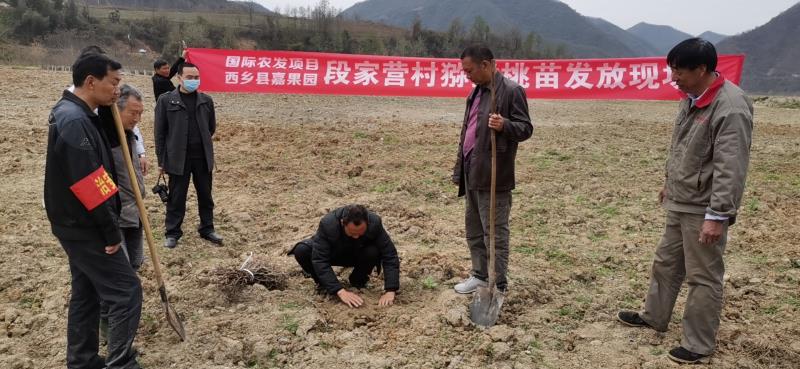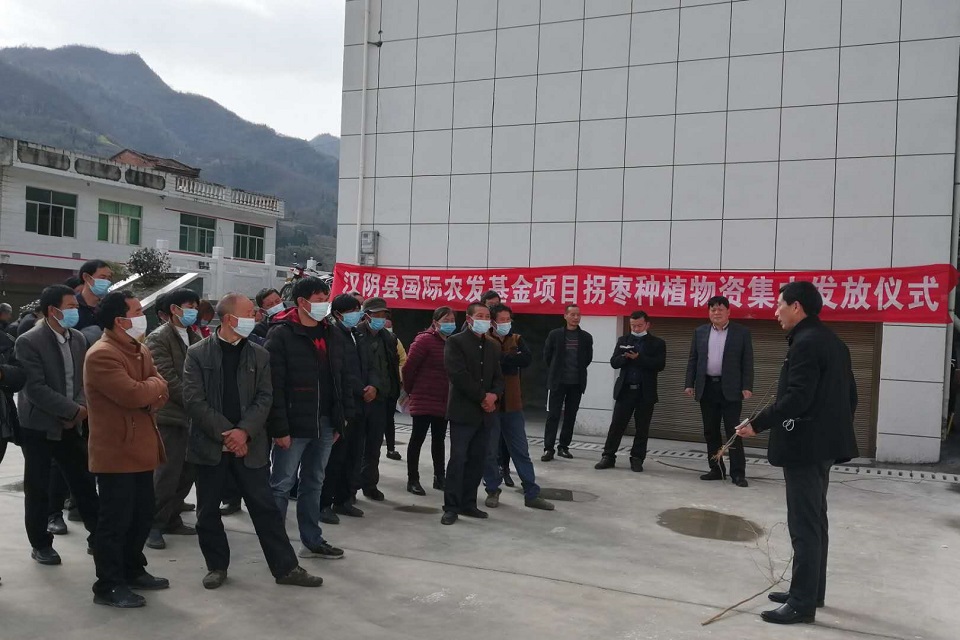The potential impact of COVID-19 on China’s food security – and prospects on food imports
p.china.org.cn by Matteo Marchisio,May 22, 2020 Adjust font size:
Last week, the China Grain Reserve Group announced its intention to purchase 22 million tonnes of imported grain in 2020.
The announcement raised some concerns on the level of food security in the country, considering the yet unclear impact of the COVID-19 pandemic on the country’s food production and distribution, and the parallel decision of some countries to ban exports of their agriculture production in anticipation of possible repercussions of COVID-19 pandemic on their own internal food supplies.
While these concerns are understandable, my opinion is that – at the moment – nothing suggests there are reasons for China to worry about food security.

Amid COVID-19, IFAD-funded SPRAD project demonstrates kiwi seedling planting techniques to smallholders in Xi Xiang District, rural Shannxi province, China. March 12, 2020, (Photo taken on March 12, 2020 by Ms. Shen Qian, IFAD)
Why China should not worry
First, every year China plans its food import quota for the year – so, this announcement does not differ, in time and content, from previous years’ announcements.
Second, while the announced quota – 22 million tonnes of grain – is slightly higher than the imported quota of cereals in 2019 (i.e. about 17 million tonnes), it is nevertheless significantly lower than the imported quota in the previous four years (i.e. 27 million tonnes in 2018, 35 million tonnes in 2017, 31 million tonnes in 2016, and 43 million tonnes in 2015) – confirming the general declining trend in China’s grain import. Overall, the planned quota of grain imports for 2020 represents only 3% of China’s annual grain consumption – confirming China has about 97% self-sufficiency level for the three main cereals consumed (wheat, rice and maize).
Third, food production has been extraordinarily high for the past several consecutive years, reaching a record 660 million tonnes of grain output in 2019. Per capita food production is above the world’s average, and food stocks are well above the 17-18% food security level suggested by the United Nation’s Food and Agriculture Organization (FAO).
In conclusion, China has sufficient food reserves to meet the internal food demand for at least one year. Despite the COVID-19 outbreak in the country in early 2020 and the decision of some countries to control food exports, I do not expect the COVID-19 outbreak to have a significant impact on food availability and food prices in the country. A recent article from the Economist seems to confirm the same at a global scale: despite the severity of today’ shock, global food supply has been maintained and food prices have not increased.
The generally positive picture is not however a reason to be complacent.
Why China should not be complacent either
The ready availability of sufficient food stocks in China has helped to keep food availability and food prices steady. Similarly, the gradual “return to normal” in most of the country seems not to have affected overall food production and distribution significantly. However, loss of employment resulting from movement restrictions to contain the COVID-19 outbreak, and the consequent loss of income, has reduced people’s ability to purchase food – even if food is actually available on the market. Purchasing capacity, not food availability, seems to be the biggest threat to food security.
The most severely impacted will obviously be the poorest and most vulnerable households, who have less capacity to cope financially with the effects of long periods of unemployment. It is estimated that in China today there are less than 6 million people living with less than US$1.90 per day, the poverty line for extreme poverty: less than 1% of the total population. However, if a US$3.20 or US$5.50 per day poverty line is adopted (the typical poverty line of lower- and upper-middle-income countries), then about 96 or 373 million people will be considered living in poverty, according to the Commission on Global Poverty. This would infer a much larger share of China’s population. This group of people largely depends on remittances from family members migrating to cities and/or in precarious or informal jobs. These families are more vulnerable to the risk of facing food insecurity in the future if immediate actions to make cash available or to quickly create income-generating opportunities are not taken today.
What are the prospects for China’s food imports in the future
It is very difficult to predict how much food China will need to import in the future.
On the one hand, food self-sufficiency (or quasi-self-sufficiency) has always been an important strategic objective of China’s agricultural policy, particularly for staple crops. China has maintained an overall 95% food self-sufficiency level over the past years, with a 97-98% self-sufficiency level for the three major staple crops: wheat, rice, and maize. If food ‘self-sufficiency’ will remain a central element of China’s policy, then we may expect that food imports will not significantly change in the future – certainly not to drastically increase (some studies forecast that China’ self-sufficiency level would settle at about 91% in 2025). The risk however is that, following the COVID-19 pandemic and a possible rise in poverty and food insecurity, countries, under the internal pressure, may decide to stockpile food, increase protectionism, and limit food exports. In this scenario, and in anticipation of possible similar events in the future, China may indeed opt to strategically increase, rather than decrease, food self-sufficiency.
On the other hand, from a purely economic and cost-efficiency point of view, lowering the self-sufficiency level may be more economically and environmentally efficient, considering the relatively high cost of domestic production (because of high labour and input costs), the rising pressure on land and environment (China feeds about 20% of the world population with only 7% of the arable land), and the potential opportunity gains for higher-value crops, such as horticulture, rather than staple food. If economic and cost-efficiency considerations prevail in the future, then we may expect an increase in food imports.
Other factors, such as a changing diet (which may lead to an increase of imports of products such as meat, milk, sugar), and demography, with China’s population approaching its peak thus stabilizing consumption, may also contribute to the equation to determine the level of food imports in the future.
From my perspective, a proper strategy should aim at maintaining a balance between a ‘comfortable level’ of self-sufficiency for staple foods and a certain level of imported foods, considering the benefits of both. Although, I acknowledge, the definition of ‘comfortable level’ would ultimately depend on political considerations – including estimating the likelihood that other countries may increase protectionism and control exports in reaction to events similar to the current COVID-19 outbreak.

Under the IFAD-funded SPRAD project, the Hanyin County Project Office distributed the agricultural materials such as seedlings and fertilizers to the beneficaries who particiated the "Hovenia Tree Planting and Processing Business Plan". (Photo by Ms. Sun Xiaojuan, PMU staff, IFAD)
How IFAD can support
First, through its projects, IFAD helps the most vulnerable people – poor rural households, smallholder farmers living in poor and remote areas, rural women – to be more resilient to shocks. IFAD supports vulnerable households to expand and diversify their income-generating opportunities and their improve livelihood options, to access more reliable sources of income, and to improve their capacity to access markets – even in situation of movement restriction, through the use of digital platforms and technologies. Initial feedback from the ongoing projects in the portfolio seems to suggest that project beneficiaries have not been majorly affected by the effects of the pandemic – suggesting that the projects have contributed to build the resilience of the beneficiaries to shocks. This would need however to be continuously monitored in the future.
Second, IFAD has been supporting smallholder farmers to focus their production on high-value agricultural products (fruits, vegetables and niche products), which are more labour intensive to produce – and thus more suitable to smallholder farming, more suitable to mountain areas – the typical areas where IFAD target groups live, more remunerative, and more economically and environmentally efficient to produce, given China’s limited availability of land and water resources – thus offering China potential opportunity gains and competitiveness in international food trade.
Matteo Marchisio is the Country Director and IFAD Representative (China, Republic of Korea, and DPRK) and Head of East Asia Regional Hub and South-South Cooperation Center.
Opinion articles reflect the views of their authors, not necessarily those of China.org.cn and Chinagate.cn.
d9f8b80f-7afa-49c3-81d6-41747b6bcab8.jpg)